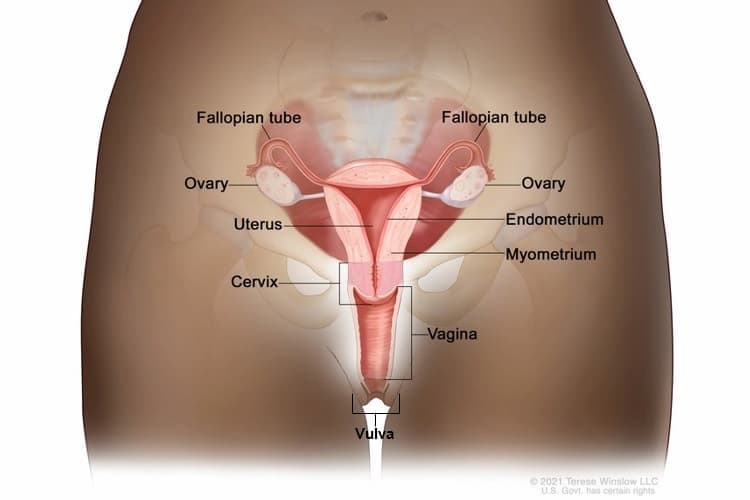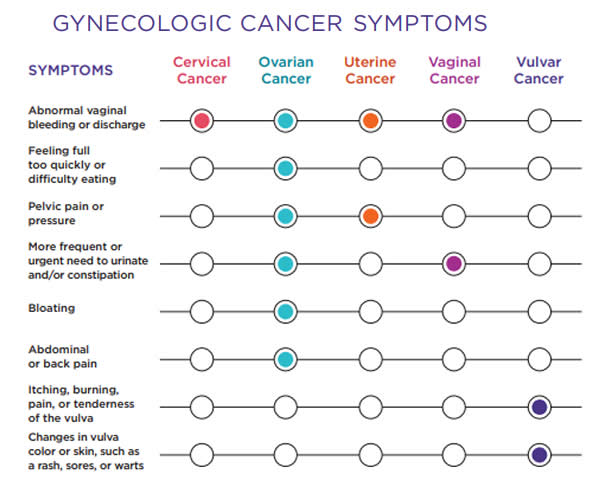Table of Contents
What Is Gynecologic Cancer?
Types of Gynecologic Cancer
- Cervical cancer begins in the cervix, which is the lower, narrow end of the uterus. (The uterus is also called the womb.)
- Ovarian cancer begins in the ovaries, which are located on each side of the uterus.
- Uterine cancer begins in the uterus, the pear-shaped organ in a woman’s pelvis where the baby grows when she is pregnant.
- Vaginal cancer begins in the vagina, which is the hollow, tube-like channel between the bottom of the uterus and the outside of the body.
- Vulvar cancer begins in the vulva, the outer part of the female genital organs.
Each gynecologic cancer is unique, with different signs and symptoms, different risk factors (things that may increase your chance of getting a disease), and different prevention strategies. All women are at risk for gynecologic cancers, and risk increases with age. When gynecologic cancers are found early, treatment is most effective.

This diagram shows different parts of a woman’s reproductive system.
What Are the Symptoms?
There is no way to know for sure if you will get a gynecologic cancer. That’s why it is important to pay attention to your body and know what is normal for you, so you can recognize the warning signs or symptoms of gynecologic cancer.
If you have vaginal bleeding that is unusual for you, talk to a doctor right away. Any vaginal bleeding after menopause needs to be reported to your doctor. If you have not yet gone through menopause but notice that your periods are heavier, last longer than normal for you, or if you’re having unusual bleeding between periods, talk to your doctor.
You should also see a doctor if you have any other warning signs that last for two weeks or longer and are not normal for you. Symptoms may be caused by something other than cancer, but the only way to know is to see a doctor.
Signs and symptoms are not the same for everyone, and each gynecologic cancer (cervical, ovarian, uterine, vaginal, and vulvar cancers) has its own signs and symptoms.

What Can I Do to Reduce My Risk?
HPV Vaccine
Some gynecologic cancers are caused by the human papillomavirus (HPV), a very common sexually transmitted infection. The HPV vaccine protects against the types of HPV that most often cause cervical, vaginal, and vulvar cancers.
- HPV vaccination is recommended for preteens aged 11 to 12 years, but can be given starting at age 9.
- HPV vaccine also is recommended for everyone through age 26 years, if they are not vaccinated already.
- HPV vaccination is not recommended for everyone older than age 26 years. However, some adults age 27 through 45 years who are not already vaccinated may decide to get the HPV vaccine after speaking with their doctor about their risk for new HPV infections and the possible benefits of vaccination. HPV vaccination in this age range provides less benefit, as more people have already been exposed to HPV.
If vaccination is started before age 15, a two-dose schedule is recommended, with the doses given 6 to 12 months apart. For people who start the series after their 15th birthday, the vaccine is given in a series of three shots.
HPV vaccination prevents new HPV infections, but does not treat existing infections or diseases. This is why the HPV vaccine works best when given before any exposure to HPV. You should get screened for cervical cancer regularly, even if you received an HPV vaccine.
Screening Tests
Screening is when a test is used to look for a disease before there are any symptoms. Cancer screening tests are effective when they can find disease early, which can lead to more effective treatment. (Diagnostic tests are used when a person has symptoms. The purpose of diagnostic tests is to find out, or diagnose, what is causing the symptoms. Diagnostic tests also may be used to check a person who is considered at high risk for cancer.)
Pap Test
Of all the gynecologic cancers, only cervical cancer has a screening test—the Pap test—that can find this cancer early, when treatment works best. The Pap test also helps prevent cervical cancer by finding precancers, cell changes on the cervix that might become cervical cancer if they are not treated appropriately.
HPV Test
A test called the HPV test looks for HPV infection. It can be used for screening women aged 30 years and older. Learn more about the Pap and HPV tests.
Recognize the Warning Signs
Since there is no simple and reliable way to screen for any gynecologic cancers except cervical cancer, it is especially important to recognize warning signs and learn if there are things you can do to reduce your risk. Talk with your doctor if you believe that you are at increased risk for gynecologic cancer. Ask what you might do to lower your risk and whether there are tests that you should have.
Types of Treatment
Gynecologic cancers are treated in several ways. It depends on the kind of cancer and how far it has spread. Treatments include surgery, chemotherapy, and radiation. Women with a gynecologic cancer often get more than one kind of treatment.
- Natural cancer treatment: read more
- Surgery: Doctors remove cancer tissue in an operation.
- Chemotherapy: Using special medicines to shrink or kill the cancer. The drugs can be pills you take or medicines given in your veins, or sometimes both.
- Radiation: Using high-energy rays (similar to X-rays) to kill the cancer.
